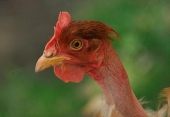Many thanks everyone for your replies, a lot of valuable information here.
I observe that commercially grown seedling that are being sold in a gardening center nearby differ from the ones I grow from seeds of (presumably) same variety.
I have tried to grow my seedling in natural light, as well as under quite powerful LED / fluorescent lights indoors, always getting same effect - seedlings reach lights very soon and I have to rise the lights to avoid burning plants.
From seeds sown in the first week of April, I have 2 feet plus tall plants by May 15th (the date of last frost). I bury them deeply, but it is not helping - first fruits form very high on the plants, while other gardeners have them almost touching ground.
During the season the plants grow vigorously, and they set flowers and fruits very far apart. No matter what is location in my backyard (and that determines amount of direct sun) and method of growing (I grow them in the soil, in grow bags and in strawbales).
Since I use my own potting mix for seedlings (based on what you guys say above), is it possible that it is too rich in nitrogen? Shall I reduce amount of
compost I add to the mix?
Finally, if nothing else helps, what varieties would you recommend that sets nodes densely and close to the ground?






 2
2





































